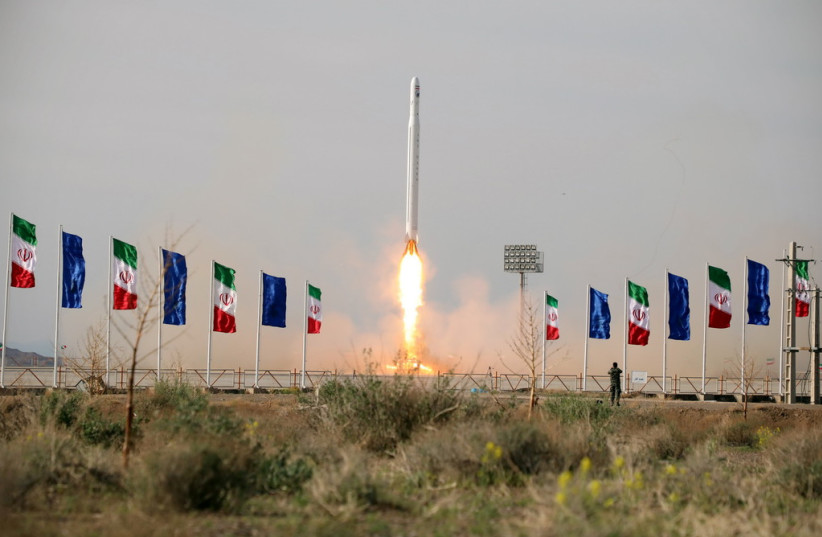Iran claimed on Wednesday that it launched a new satellite into orbit. It sees this as a major achievement. The Iranian regime has hinted about the launch for months.
It is part of a number of new technological successes that Iran presents as showcasing its abilities. This includes the Iranian drone and missile programs.
Iran's Communication Minister Isa Zarepour said the Noor-3 satellite had been put in an orbit 450 kilometers (280 miles) above the Earth's surface, the state-run IRNA news agency reported. The Islamic Revolution Guards Corps (IRGC) Aerospace Force announced the launch.
They describe the satellite as an imaging satellite. This would make it a satellite with potential spying capabilities, boosting Iran’s abilities in space. As with any claim by Iran, it’s worth noting that not everything may work as well as Tehran claims it does.
The head of Iran’s IRGC Hossein Salami said that the new satellite has imaging equipment with better accuracy and quality and “naturally completes one of the links in our satellite chain.” The last part of his statement seems to indicate that having multiple satellites might provide more coverage and coverage of the earth at all times for Iran.
Meanwhile the Iranian head of the IRGC Aerospace unit Amir Ali Hajizadeh said that said the new satellite has capabilities such as “imaging in different light spectrums with high quality and resolution, telecommunication relay services, sending commands and receiving data over long distances in real time, for example for drones and sea vessels, and finally global positioning services for missile guidance and navigation systems.”
This shows Iran plans to use the new system for potential attacks throughout the region. Iran says it will help meet the needs of its military forces. Hajizadeh says Iran will launch more satellites in near future.
However, Iran’s own Tasnim media, which is close to the IRGC boasted about the fact it is Iran’s third “military satellite.” The report says “the imaging satellite was launched with a homegrown satellite carrier, dubbed Qassed.” Iran previously launched the Noor 1 in April 2020 and the Noor 2 in March 2022. “All three satellites have been sent into orbit by the Qassed satellite carrier, designed and manufactured by the IRGC Aerospace Force.”

The launch comes amid several important moves in the region and globally. First of all it comes a day after a mysterious explosion in western Iran. It also comes after reports that Israel and Saudi Arabia continue on a path towards peace.
This means that Iran wants to showcase it abilities during a time of transition and diplomatic shifts in the region. Iran has also been holding talks with Turkey about shifts in the Caucasus. In addition Iran sent key officials to Vienna for a recent meeting of the IAEA.
As such, Iran now sits astride important developments in the Middle East and also important developments that link Russia and China to Tehran. Iran’s goal is multi-layered. It wants satellite technology for its own pride and its own ends. That means it wants to launch satellites in order to be one of the global space players.
But participating in the space race is not a goal unto itself. Many countries such as the UAE and India are all taking a greater interest in space. Iran wants to have a military capability in space and it wants to use this to improve its missile program. This includes investment in hypersonic weapons that include a missile that might be able to be launched towards space and have a re-entry vehicle travel back to earth at hypersonic speeds to strike a target.
Iran investing heavily in its space and missile program
The satellite launch comes amidst revelations about Iran’s attempt to influence the West during the leadup to the 2015 Iran deal. What this illustrates is that Iran has been investing heavily in its space and missile programs, in tandem with the nuclear program. Tehran knows that the Saudis and others do not want to see Iran achieve a nuclear weapon. However, that does not mean Iran will stop enrichment of uranium, only that it will keep one step below the threshold status of testing a weapon.
To have a successful nuclear weapons program, Iran needs long range missiles on which it could put a weapon. Therefore it makes sense for Iran to continue to focus on missile and space technology for now. As such, the satellite’s goal is to be in orbit casting a shadow over the Middle East, evidence of another achievement by Tehran and the IRGC.
